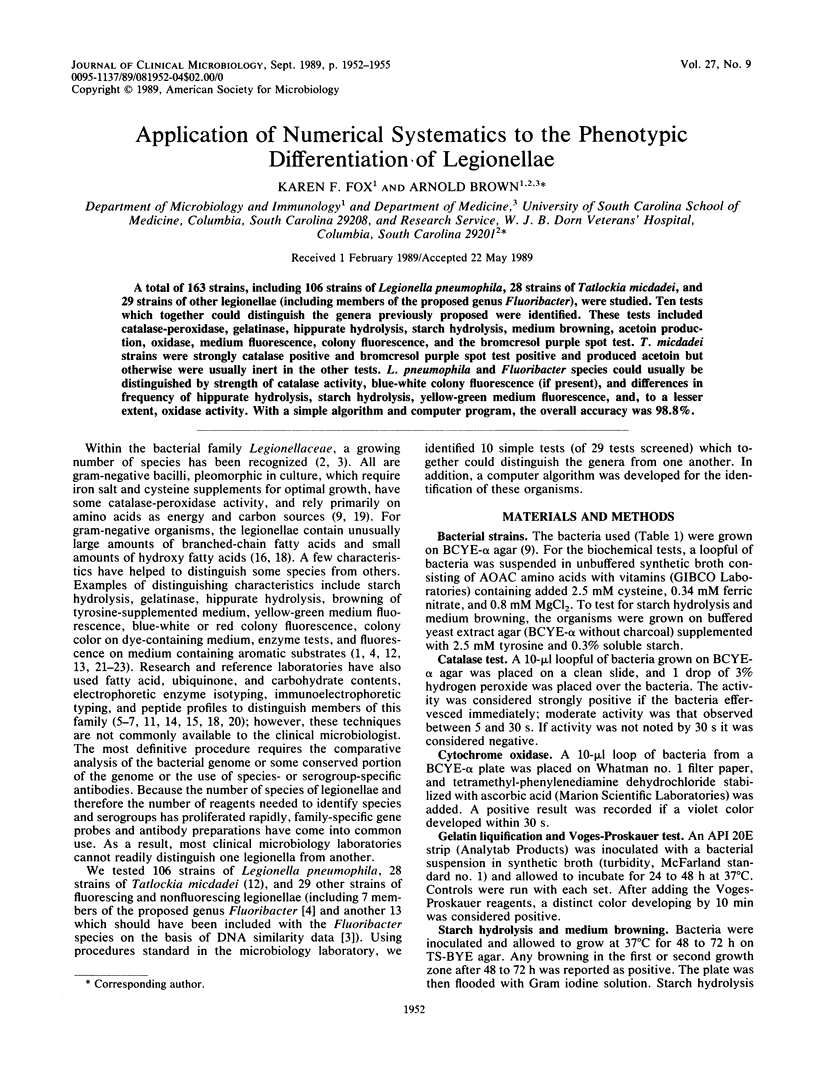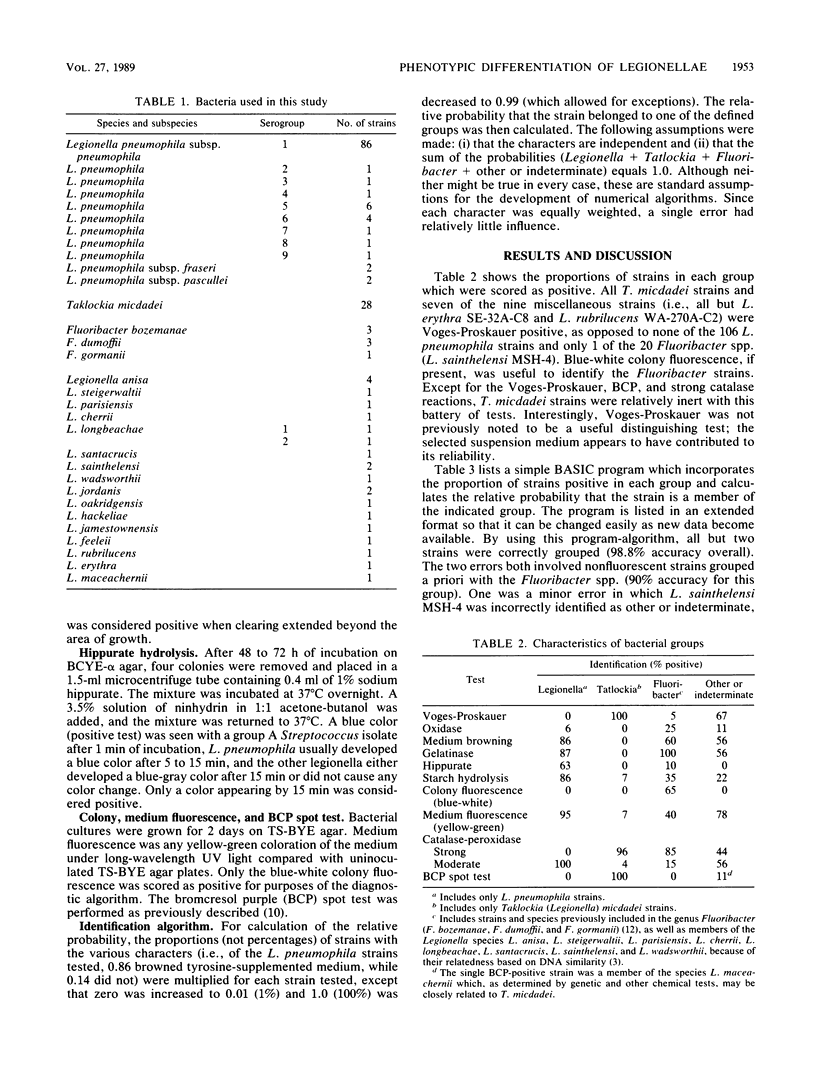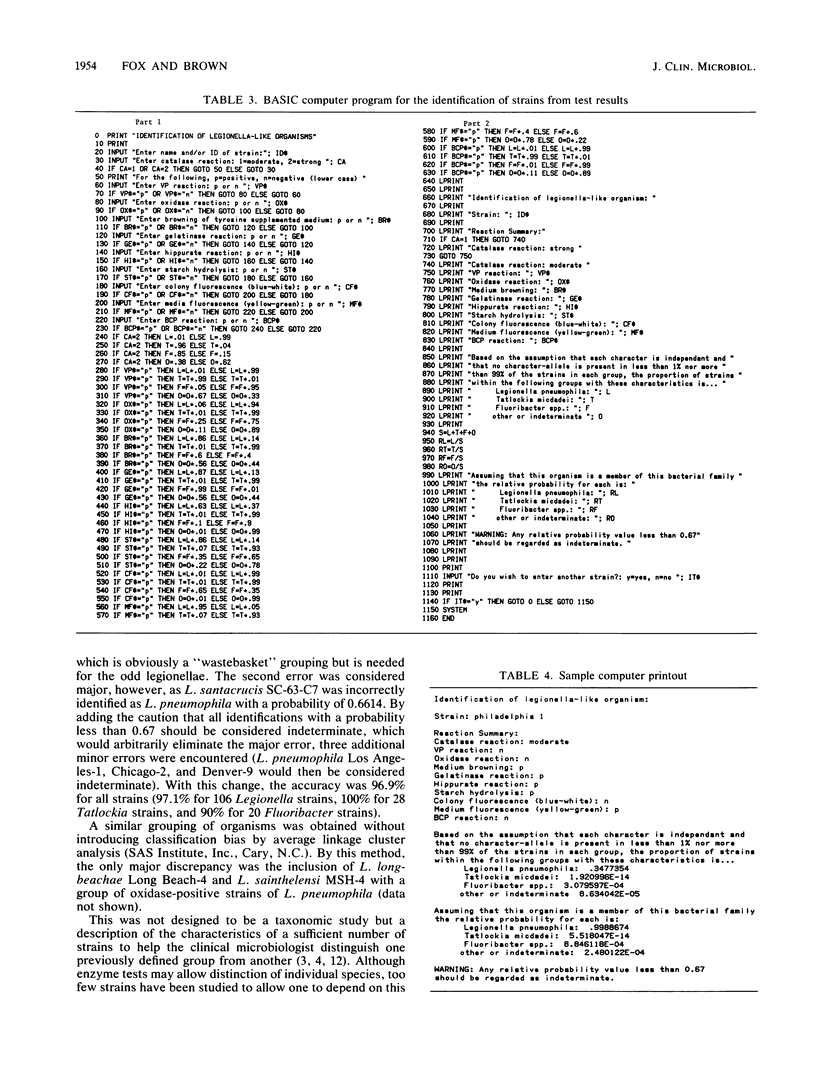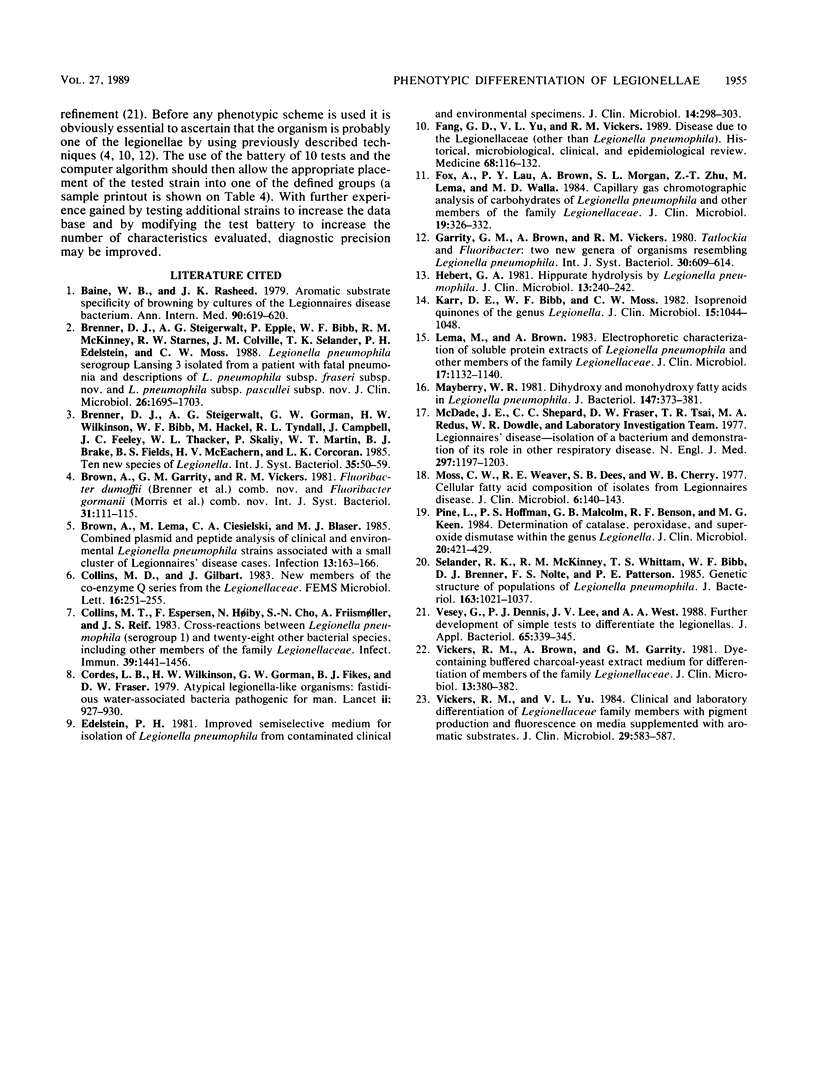Abstract
A total of 163 strains, including 106 strains of Legionella pneumophila, 28 strains of Tatlockia micdadei, and 29 strains of other legionellae (including members of the proposed genus Fluoribacter), were studied. Ten tests which together could distinguish the genera previously proposed were identified. These tests included catalase-peroxidase, gelatinase, hippurate hydrolysis, starch hydrolysis, medium browning, acetoin production, oxidase, medium fluorescence, colony fluorescence, and the bromcresol purple spot test. T. micdadei strains were strongly catalase positive and bromcresol purple spot test positive and produced acetoin but otherwise were usually inert in the other tests. L. pneumophila and Fluoribacter species could usually be distinguished by strength of catalase activity, blue-white colony fluorescence (if present), and differences in frequency of hippurate hydrolysis, starch hydrolysis, yellow-green medium fluorescence, and, to a lesser extent, oxidase activity. With a simple algorithm and computer program, the overall accuracy was 98.8%.
Full text
PDF



Selected References
These references are in PubMed. This may not be the complete list of references from this article.
- Baine W. B., Rasheed J. K. Aromatic substrate specificity of browning by cultures of the Legionnaires' disease bacterium. Ann Intern Med. 1979 Apr;90(4):619–620. doi: 10.7326/0003-4819-90-4-619. [DOI] [PubMed] [Google Scholar]
- Brenner D. J., Steigerwalt A. G., Epple P., Bibb W. F., McKinney R. M., Starnes R. W., Colville J. M., Selander R. K., Edelstein P. H., Moss C. W. Legionella pneumophila serogroup Lansing 3 isolated from a patient with fatal pneumonia, and descriptions of L. pneumophila subsp. pneumophila subsp. nov., L. pneumophila subsp. fraseri subsp. nov., and L. pneumophila subsp. pascullei subsp. nov. J Clin Microbiol. 1988 Sep;26(9):1695–1703. doi: 10.1128/jcm.26.9.1695-1703.1988. [DOI] [PMC free article] [PubMed] [Google Scholar]
- Brown A., Lema M., Ciesielski C. A., Blaser M. J. Combined plasmid and peptide analysis of clinical and environmental Legionella pneumophila strains associated with a small cluster of Legionnaires' disease cases. Infection. 1985 Jul-Aug;13(4):163–166. doi: 10.1007/BF01642803. [DOI] [PubMed] [Google Scholar]
- Collins M. T., Espersen F., Høiby N., Cho S. N., Friis-Møller A., Reif J. S. Cross-reactions between Legionella pneumophila (serogroup 1) and twenty-eight other bacterial species, including other members of the family Legionellaceae. Infect Immun. 1983 Mar;39(3):1441–1456. doi: 10.1128/iai.39.3.1441-1456.1983. [DOI] [PMC free article] [PubMed] [Google Scholar]
- Cordes L. G., Wilkinson H. W., Gorman G. W., Fikes B. J., Fraser D. W. Atypical Legionella-like organisms: fastidious water-associated bacteria pathogenic for man. Lancet. 1979 Nov 3;2(8149):927–930. doi: 10.1016/s0140-6736(79)92623-0. [DOI] [PubMed] [Google Scholar]
- Edelstein P. H. Improved semiselective medium for isolation of Legionella pneumophila from contaminated clinical and environmental specimens. J Clin Microbiol. 1981 Sep;14(3):298–303. doi: 10.1128/jcm.14.3.298-303.1981. [DOI] [PMC free article] [PubMed] [Google Scholar]
- Fang G. D., Yu V. L., Vickers R. M. Disease due to the Legionellaceae (other than Legionella pneumophila). Historical, microbiological, clinical, and epidemiological review. Medicine (Baltimore) 1989 Mar;68(2):116–132. doi: 10.1097/00005792-198903000-00005. [DOI] [PubMed] [Google Scholar]
- Fox A., Lau P. Y., Brown A., Morgan S. L., Zhu Z. T., Lema M., Walla M. D. Capillary gas chromatographic analysis of carbohydrates of Legionella pneumophila and other members of the family Legionellaceae. J Clin Microbiol. 1984 Mar;19(3):326–332. doi: 10.1128/jcm.19.3.326-332.1984. [DOI] [PMC free article] [PubMed] [Google Scholar]
- Hébert G. A. Hippurate hydrolysis by Legionella pneumophila. J Clin Microbiol. 1981 Jan;13(1):240–242. doi: 10.1128/jcm.13.1.240-242.1981. [DOI] [PMC free article] [PubMed] [Google Scholar]
- Karr D. E., Bibb W. F., Moss C. W. Isoprenoid quinones of the genus Legionella. J Clin Microbiol. 1982 Jun;15(6):1044–1048. doi: 10.1128/jcm.15.6.1044-1048.1982. [DOI] [PMC free article] [PubMed] [Google Scholar]
- Lema M., Brown A. Electrophoretic characterization of soluble protein extracts of Legionella pneumophila and other members of the family Legionellaceae. J Clin Microbiol. 1983 Jun;17(6):1132–1140. doi: 10.1128/jcm.17.6.1132-1140.1983. [DOI] [PMC free article] [PubMed] [Google Scholar]
- Mayberry W. R. Dihydroxy and monohydroxy fatty acids in Legionella pneumophila. J Bacteriol. 1981 Aug;147(2):373–381. doi: 10.1128/jb.147.2.373-381.1981. [DOI] [PMC free article] [PubMed] [Google Scholar]
- McDade J. E., Shepard C. C., Fraser D. W., Tsai T. R., Redus M. A., Dowdle W. R. Legionnaires' disease: isolation of a bacterium and demonstration of its role in other respiratory disease. N Engl J Med. 1977 Dec 1;297(22):1197–1203. doi: 10.1056/NEJM197712012972202. [DOI] [PubMed] [Google Scholar]
- Moss C. W., Weaver R. E., Dees S. B., Cherry W. B. Cellular fatty acid composition of isolates from Legionnaires disease. J Clin Microbiol. 1977 Aug;6(2):140–143. doi: 10.1128/jcm.6.2.140-143.1977. [DOI] [PMC free article] [PubMed] [Google Scholar]
- Pine L., Hoffman P. S., Malcolm G. B., Benson R. F., Keen M. G. Determination of catalase, peroxidase, and superoxide dismutase within the genus Legionella. J Clin Microbiol. 1984 Sep;20(3):421–429. doi: 10.1128/jcm.20.3.421-429.1984. [DOI] [PMC free article] [PubMed] [Google Scholar]
- Selander R. K., McKinney R. M., Whittam T. S., Bibb W. F., Brenner D. J., Nolte F. S., Pattison P. E. Genetic structure of populations of Legionella pneumophila. J Bacteriol. 1985 Sep;163(3):1021–1037. doi: 10.1128/jb.163.3.1021-1037.1985. [DOI] [PMC free article] [PubMed] [Google Scholar]
- Vesey G., Dennis P. J., Lee J. V., West A. A. Further development of simple tests to differentiate the legionellas. J Appl Bacteriol. 1988 Oct;65(4):339–345. doi: 10.1111/j.1365-2672.1988.tb01900.x. [DOI] [PubMed] [Google Scholar]
- Vickers R. M., Brown A., Garrity G. M. Dye-containing buffered charcoal-yeast extract medium for differentiation of members of the family Legionellaceae. J Clin Microbiol. 1981 Feb;13(2):380–382. doi: 10.1128/jcm.13.2.380-382.1981. [DOI] [PMC free article] [PubMed] [Google Scholar]
- Vickers R. M., Yu V. L. Clinical laboratory differentiation of Legionellaceae family members with pigment production and fluorescence on media supplemented with aromatic substrates. J Clin Microbiol. 1984 May;19(5):583–587. doi: 10.1128/jcm.19.5.583-587.1984. [DOI] [PMC free article] [PubMed] [Google Scholar]


